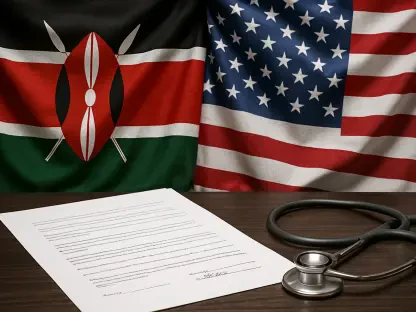The world is grappling with an alarming downturn in global health financing, a crisis that jeopardizes the well-being of millions, particularly in developing nations where health systems are already fragile and under-resourced. Development Assistance for Health (DAH), a critical lifeline for health initiatives in low-income countries, has reached its lowest point in over 15 years, signaling a troubling reversal of decades of progress. Recent data paints a grim picture, with funding levels plummeting and major donors stepping back from their commitments at a time when the need for support is more urgent than ever. This drastic reduction not only threatens to dismantle essential health programs but also risks amplifying existing disparities between high- and low-income nations. As the international community stands at this pivotal moment, the stakes could not be higher—lives hang in the balance, and the hard-won gains in reducing mortality and improving health outcomes are on the brink of being undone.
The Alarming Decline in Health Aid
The scale of the current financial shortfall in global health aid is nothing short of staggering, with immediate and far-reaching consequences for vulnerable populations. Estimates place DAH at a mere $39.1 billion in the current year, reflecting a dramatic drop of over 20% compared to last year’s figures. Projections indicate an even bleaker future, with funding expected to dwindle further to $36.2 billion by 2030 if current trends persist. This decline is not merely a budgetary concern; it translates into real-world impacts, as health programs that provide life-saving interventions face the threat of collapse. Low-income countries, which rely heavily on this assistance to bolster their underfunded health systems, are left scrambling to address gaps that could mean the difference between life and death for millions. The urgency of this situation cannot be overstated, as the reduction in resources directly undermines the ability to deliver critical care and preventive measures to those who need them most.
Beyond the raw numbers, the decline in DAH reveals a troubling shift in global priorities that could reshape health landscapes for years to come. The funding cuts are driven by significant reductions from key donors, signaling a retreat from international health commitments at a critical juncture. This pullback affects not just the quantity of aid but also the confidence in sustained support, leaving health organizations and recipient nations in a state of uncertainty. For many developing countries, the absence of reliable funding streams hampers long-term planning and investment in health infrastructure, perpetuating a cycle of dependency and vulnerability. Moreover, the shortfall disrupts ongoing initiatives targeting major health challenges, such as infectious diseases and maternal care, which have historically benefited from consistent international support. As the gap widens, the international community must confront the reality that without swift intervention, the progress made in global health could erode rapidly.
Devastating Impact of Donor Reductions
Major donors, historically the backbone of global health financing, are implementing severe cuts that send shockwaves through the entire system. Countries like the United States, the United Kingdom, France, and Germany have significantly reduced their contributions, with the US leading the way by slashing its aid by a staggering $9 billion, equivalent to a 67% reduction. This dramatic retreat impacts not just the total funding pool but also the operational capacity of intermediaries such as NGOs and foundations, which face a collective shortfall of approximately $2.5 billion. International health organizations, including the World Health Organization and Gavi, the Vaccine Alliance, are also grappling with funding decreases ranging from 5% to 18%. These reductions threaten the stability of programs that deliver essential services, from vaccinations to disease prevention, leaving health systems in developing nations dangerously exposed to crises they cannot manage alone.
The ripple effects of these donor cuts disproportionately burden the most vulnerable populations, deepening existing inequities in global health. High-income countries continue to spend 299 times more per person on health compared to low-income nations, where per capita health expenditure is projected to remain at a dismal $40 by 2030. This vast disparity means that access to basic medical care becomes an unattainable luxury for millions, as underfunded health systems struggle to provide even the most fundamental services. The consequences are dire, with preventable illnesses and treatable conditions likely to claim more lives in regions already battling poverty and limited resources. The funding crisis exacerbates the divide, pushing low-income countries further behind and highlighting the urgent need for a more equitable distribution of health resources on a global scale to ensure that no one is left behind in the fight for better health outcomes.
Reversing Hard-Won Health Gains
Reflecting on the past, the transformative impact of sustained DAH underscores the catastrophic potential of the current funding crisis. Over the last two decades, initiatives supported by agencies like USAID have saved over 91 million lives globally, including 30 million children, through targeted interventions against devastating conditions such as HIV/AIDS, malaria, and neglected tropical diseases. These efforts have slashed mortality rates significantly, with reductions of 65% for HIV/AIDS and 51% for malaria, demonstrating the tangible benefits of committed international support. However, the sharp decline in funding threatens to undo these achievements, as health programs that once thrived on consistent aid now face uncertainty and potential collapse. The loss of such progress would not only be a setback for global health but also a profound failure to protect the most defenseless populations from preventable suffering.
Looking ahead, the projections tied to these funding cuts paint a harrowing picture of increased mortality and diminished health outcomes. Experts estimate that the reductions could result in an additional 14 million deaths by 2030, with over 4.5 million of those being children under five, averaging a heartbreaking 2.4 million deaths each year. This looming tragedy serves as a stark reminder of what is at stake when financial support wanes, particularly for young lives that depend on interventions like vaccinations and nutritional programs. The potential reversal of decades of progress demands immediate attention, as the international community must grapple with the moral and practical implications of allowing such preventable losses to occur. Addressing this crisis requires not only restoring funding but also ensuring that resources are directed where they can have the greatest impact on saving lives and sustaining health advancements.
Structural Barriers in Health Financing
Compounding the crisis of reduced funding are deep-seated systemic issues that hinder effective health financing in many low-income countries. A significant challenge lies in inadequate domestic revenue generation, with numerous nations maintaining tax-to-GDP ratios below 15%, far too low to support robust health systems without external aid. This fiscal limitation means that even basic health services remain underfunded, leaving populations exposed to preventable diseases and emergencies that could be mitigated with better resources. The dependency on foreign assistance, now shrinking, exacerbates the vulnerability of these countries, as they lack the financial autonomy to respond to health needs independently. Addressing this structural barrier is critical to building resilience, but it requires long-term policy reforms and international cooperation to enhance local capacity for sustainable health funding.
Additionally, inefficiencies in how health aid is allocated and spent further aggravate the crisis, wasting precious resources at a time when every dollar counts. Fragmented aid distribution often results in duplicated efforts or misaligned priorities, with some regions receiving disproportionate support while others are neglected. Studies highlight stark variations in spending efficiency across countries, pointing to systemic flaws that prevent funds from reaching their intended impact. This inefficiency not only undermines the effectiveness of existing aid but also erodes trust in global health initiatives, as stakeholders question whether resources are being used wisely. Tackling these challenges demands a concerted effort to streamline aid mechanisms, improve transparency, and align funding with the most pressing health needs, ensuring that limited resources achieve maximum benefit for those in greatest need.
Pathways to Safeguard Global Health
In the face of this unprecedented funding crisis, innovative solutions and strategic reprioritization emerge as vital tools to protect global health gains. Experts advocate for exploring alternative financing mechanisms, drawing inspiration from commitments like the Gates Foundation’s pledge to invest $200 billion by 2045 to combat diseases such as polio and malaria. While such initiatives offer hope, they alone cannot bridge the vast funding gap left by donor cuts. A broader approach must include enhancing aid efficiency through better coordination among international bodies and ensuring that resources are targeted where they can save the most lives. Additionally, fostering partnerships between public and private sectors could unlock new funding streams, providing a buffer against the volatility of traditional aid. The urgency of adopting these measures cannot be overstated, as the health of millions depends on swift and creative responses to the current shortfall.
Equally critical is the need for recipient countries to strengthen their domestic resource mobilization to build resilience against external funding shocks. Increasing tax revenues and allocating a greater share to health budgets can help reduce dependency on foreign aid, creating a more sustainable foundation for health systems. International support should focus on capacity-building initiatives that empower nations to manage their health challenges independently, from improving fiscal policies to training healthcare workers. While the road to self-sufficiency is long, incremental progress in domestic financing could mitigate the impact of global aid reductions. As the funding landscape continues to shift, a dual strategy of innovation in international support and empowerment of local systems offers the best chance to safeguard past achievements and prevent a catastrophic rollback in global health progress.









